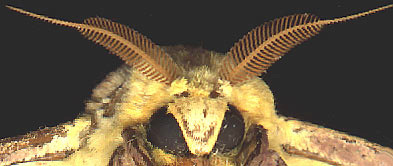Excerpts from Jim Conrad's
Naturalist Newsletter
from the August 4, 2002 Newsletter issued from the woods near Natchez, Mississippi, USA
LAST HOURS OF AN IMPERIAL MOTH
Tuesday at dawn as I jogged through the woods I came upon a yellowish, 4-inch across moth (10 cm) lying on its back quivering, and it was clear that it was dying. It was the Imperial Moth, EACLES IMPERIALIS, shown below.

A close-up of it head is shown below:

I wasn't able to identify it immediately. Three or four species of very large, spectacular moths occur here, maybe the most common being the Luna Moth, but this wasn't one I had seen. Because the species wasn't illustrated in my field guides I went onto the Internet to identify it. There I learned that the Imperial Moth's caterpillars eat the foliage of pines, oaks, Box Elder, maples, Sweet Gum and Sassafras -- all trees present in this area. The site's remark under "adult food" was a poignant one. It read "Adults do not feed."
In other words, this species spends nearly all of its life in the caterpillar stage. When it finally metamorphoses it lives for only a couple of days, during which time it must find a mate, copulate, and then the female must lay eggs. Once these tasks are finished, the adults simply die. They run out of energy. My moth quivered and twitched for about 3 hours, and then died atop my scanner.
That nature would create an adult stage for which the whole idea is just to procreate and then to quickly die, and for this adult stage to be so beautiful, is something worth thinking about, something perhaps a little scary.
You may have seen this species' strange-looking caterpillar, which is green and hairy, with its rear end designed to look like more like a head than the head does -- so that a predator might attack the critter's butt, not the head.
from the December 12, 2010 Newsletter issued from Hacienda Chichen Resort beside Chichén Itzá Ruins, central Yucatán, MÉXICO
SANTOS'S BLACK MUMMY
Santos of the garden crew is not an ebullient person. Some would say he's subdued. However, when he came to the hut door this week he was chuckling as I'd never heard, for he'd done it again: Two weeks earlier he'd brought me the highly ornamented chrysalis of a Blomfild's Beauty Butterfly, last week it was a monstrously large grub, probably of a Rhinoceros Beetle, and now here he was with this thing shown below:

It was two inches long (5 cm) and as it lay in my hand it stiffly and faintly squirmed back and forth. It'd turned up in soil containing lots of rotting wood. Clearly it's the resting stage, or pupa, of a lepidopterous insect -- butterfly or moth. Most moth pupas are cocoons made of silk. Most butterflies form exposed pupas, called chrysalises, like that of our Blomfild's Beauty. However there are so many exceptions to this rule that sometimes it's hard to say whether you have a butterfly or moth pupa.
Good ol' volunteer insect-identifier Bea in Ontario knew that this would be a hard one. In the end we're comfortable saying that probably Santos had brought me a pupa of a moth belonging to the Giant Silk Moth Family. On the Internet pupae in the Subfamily Ceratocampinae look a lot like ours. I find only one giant silk moth having been collected in our area, the Imperial Moth, EACLES IMPERIALIS QUINTANENSIS.
The third part of that name, quintanensis, denotes the subspecies, and refers to the specimen having been collected in the state to our east, Quintana Roo. All Giant Silk Moths are essentially sex machines. Adult moths exit their pupa with the sole goal of finding a member of the opposite sex, mating and producing offspring. They don't even eat, having no mouthparts to enable it.
Is our pupa really that of an Imperial Moth? A list of Silk Moths of Shipstern Nature Reserve in Belize lists six Ceratocampinae for that area, though only one Eacles, and that's the Imperial Moth. "Imperial Moth" is a good, bet but not a certainty.
I reburied the pupa and hope for the same luck I had with the adult Blomfild's Beauty.
By the way, you can see why so many insects would be appearing nowadays in their pupal stages. As the dry season continues to bear down, more and more trees and shrubs lose their leaves, herbs die back and in some places it's just hard to find water. Ecologically our dry season imposes pressures and dangers every bit as critical as the North's coldness. It's a good time to go underground, to pass time until rains and flowers return, to be a pupa.